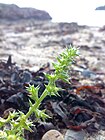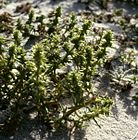Note: This is a project under development. The articles on this wiki are just being initiated and broadly incomplete. You can Help creating new pages.
Difference between revisions of "Salsola kali"
(Created page with "{{stub}} ==Uses== {{Uses|}}, {{Uses|}}, {{Uses|}}, {{Uses|}}, {{Uses|}}, {{Uses|}}, {{Uses|}}, {{Uses|}}, {{Uses|}}, {{Uses|}}, {{Uses|}}.<ref name="Uses"/> ==Parts Used== {{...") |
|||
| Line 1: | Line 1: | ||
| − | + | [[File:Salsola kali 01.jpg|thumb|right]] | |
| + | '''Salsola kali''' is an annual plant that can grow up to 0.60 metres tall. It is harvested from the wild for local use as a food, medicine and source of materials. | ||
==Uses== | ==Uses== | ||
| − | {{Uses|}}, {{Uses|}}, {{Uses| | + | {{Uses|Blood pressure}}, {{Uses|Dropsy}}, {{Uses|Excrescences}}.<ref name="Uses"/> |
==Parts Used== | ==Parts Used== | ||
| − | {{Parts Used|}}, {{Parts Used| | + | {{Parts Used|Young leaves}}, {{Parts Used|Stems}}, {{Parts Used|Seeds}}. |
==Chemical Composition== | ==Chemical Composition== | ||
| − | <ref name="chemical composition"/> | + | It contains ferulic acid (1), p-coumaric acid (2), salicylic acid (3), tricin (4), selagin (5), acanthoside D (6), tricin -7-O-beta-D-glucopyranoside (7), tricin-4'-O-beta-D-apioside (8), isorhamnetin-7-O-beta-D-glucopyranoside (9), isorhamnetin-3-O-beta-D-glucopyranoside (10), isorhamnetin-3-O-alpha-L-arabinopyranosyl (1-->6) -beta-D-glucopyranoside<ref name="chemical composition"/> |
==Common names== | ==Common names== | ||
| Line 16: | Line 17: | ||
===Dravya=== | ===Dravya=== | ||
===Rasa=== | ===Rasa=== | ||
| − | |||
===Guna=== | ===Guna=== | ||
| Line 29: | Line 29: | ||
==Habit== | ==Habit== | ||
| − | {{Habit|}} | + | {{Habit|Annual}} |
==Identification== | ==Identification== | ||
| Line 48: | Line 48: | ||
==Mode of Propagation== | ==Mode of Propagation== | ||
| − | {{Propagation|}} | + | {{Propagation|Seeds}} |
==How to plant/cultivate== | ==How to plant/cultivate== | ||
| − | <ref name="How to plant/cultivate"/> | + | Requires a very sunny position in a light or medium well-drained soil. Tolerates maritime exposure. The plant is reported to tolerate an annual precipitation in the range of 26 to 97cm, an annual temperature in the range of 9.2 to 23.8°C and a pH of 7.0 to 7.9.<ref name="How to plant/cultivate"/> |
==Commonly seen growing in areas== | ==Commonly seen growing in areas== | ||
| − | {{Commonly seen|}}, {{Commonly seen|}}, {{Commonly seen| | + | {{Commonly seen|Non-saline sandy beaches}}, {{Commonly seen|Avoiding acid soils}}, {{Commonly seen|Found on dry soils}}. |
==Photo Gallery== | ==Photo Gallery== | ||
<gallery class="left" caption="" widths="140px" heights="140px"> | <gallery class="left" caption="" widths="140px" heights="140px"> | ||
| − | + | Salsola kali 01.jpg | |
| + | Salsola kali 1.JPG | ||
| + | Salsola kali flowers.jpg | ||
| + | 2015 06 Strandpflanze3.JPG | ||
| + | Salsola kali Helgoland.JPG | ||
| + | Salsola kali subsp. kali kz03.jpg | ||
</gallery> | </gallery> | ||
| Line 64: | Line 69: | ||
<references> | <references> | ||
| − | <ref name="chemical composition">[ | + | <ref name="chemical composition">[https://www.researchgate.net/publication/6321637_Studies_on_chemical_constituents_of_Salsola_collina Chemical constituents]</ref> |
| − | <ref name="Leaf">[ | + | <ref name="Leaf">[Morphology]</ref> |
| − | <ref name="How to plant/cultivate">[ | + | <ref name="How to plant/cultivate">[http://temperate.theferns.info/plant/Salsola+kali Cultivation]</ref> |
<ref name="Uses">Indian Medicinal Plants by C.P.Khare</ref> | <ref name="Uses">Indian Medicinal Plants by C.P.Khare</ref> | ||
</references> | </references> | ||
==External Links== | ==External Links== | ||
| − | * [ ] | + | * [https://www.flowersofindia.net/catalog/slides/Prickly%20Russian%20Thistle.html#:~:text=tragus%20%2D%20Prickly%20Russian%20Thistle&text=Prickly%20Russian%20Thistle%20is%20an,up%20to%20a%20meter%20long.&text=Prickly%20Russian%20Thistle%20is%20native,found%20in%20Kashmir%20and%20Ladakh. Salsola kali on flowersofindia.net] |
| − | * [ ] | + | * [https://wiki.bugwood.org/Salsola_kali Salsola kali on wiki.bugwood.org] |
| − | * [ ] | + | * [https://www.cabi.org/isc/datasheet/50297 Salsola kali on cabi.org] |
[[Category:Herbs]] | [[Category:Herbs]] | ||
Latest revision as of 16:07, 3 August 2020
Salsola kali is an annual plant that can grow up to 0.60 metres tall. It is harvested from the wild for local use as a food, medicine and source of materials.
Contents
- 1 Uses
- 2 Parts Used
- 3 Chemical Composition
- 4 Common names
- 5 Properties
- 6 Habit
- 7 Identification
- 8 List of Ayurvedic medicine in which the herb is used
- 9 Where to get the saplings
- 10 Mode of Propagation
- 11 How to plant/cultivate
- 12 Commonly seen growing in areas
- 13 Photo Gallery
- 14 References
- 15 External Links
Uses
Blood pressure, Dropsy, Excrescences.[1]
Parts Used
Chemical Composition
It contains ferulic acid (1), p-coumaric acid (2), salicylic acid (3), tricin (4), selagin (5), acanthoside D (6), tricin -7-O-beta-D-glucopyranoside (7), tricin-4'-O-beta-D-apioside (8), isorhamnetin-7-O-beta-D-glucopyranoside (9), isorhamnetin-3-O-beta-D-glucopyranoside (10), isorhamnetin-3-O-alpha-L-arabinopyranosyl (1-->6) -beta-D-glucopyranoside[2]
Common names
| Language | Common name |
|---|---|
| Kannada | |
| Hindi | |
| Malayalam | |
| Tamil | |
| Telugu | |
| Marathi | |
| Gujarathi | |
| Punjabi | |
| Kashmiri | |
| Sanskrit | |
| English |
Properties
Reference: Dravya - Substance, Rasa - Taste, Guna - Qualities, Veerya - Potency, Vipaka - Post-digesion effect, Karma - Pharmacological activity, Prabhava - Therepeutics.
Dravya
Rasa
Guna
Veerya
Vipaka
Karma
Prabhava
Habit
Identification
Leaf
| Kind | Shape | Feature |
|---|---|---|
Flower
| Type | Size | Color and composition | Stamen | More information |
|---|---|---|---|---|
| {{{5}}} |
Fruit
| Type | Size | Mass | Appearance | Seeds | More information |
|---|---|---|---|---|---|
Other features
List of Ayurvedic medicine in which the herb is used
Where to get the saplings
Mode of Propagation
How to plant/cultivate
Requires a very sunny position in a light or medium well-drained soil. Tolerates maritime exposure. The plant is reported to tolerate an annual precipitation in the range of 26 to 97cm, an annual temperature in the range of 9.2 to 23.8°C and a pH of 7.0 to 7.9.[4]
Commonly seen growing in areas
Non-saline sandy beaches, Avoiding acid soils, Found on dry soils.
Photo Gallery
References
- ↑ Indian Medicinal Plants by C.P.Khare
- ↑ Chemical constituents
- ↑ [Morphology]
- ↑ Cultivation
External Links
- Ayurvedic Herbs known to be helpful to treat Blood pressure
- Ayurvedic Herbs known to be helpful to treat Dropsy
- Ayurvedic Herbs known to be helpful to treat Excrescences
- Herbs with Young leaves used in medicine
- Herbs with Stems used in medicine
- Herbs with Seeds used in medicine
- Habit - Annual
- Index of Plants which can be propagated by Seeds
- Herbs that are commonly seen in the region of Non-saline sandy beaches
- Herbs that are commonly seen in the region of Avoiding acid soils
- Herbs that are commonly seen in the region of Found on dry soils
- Herbs






